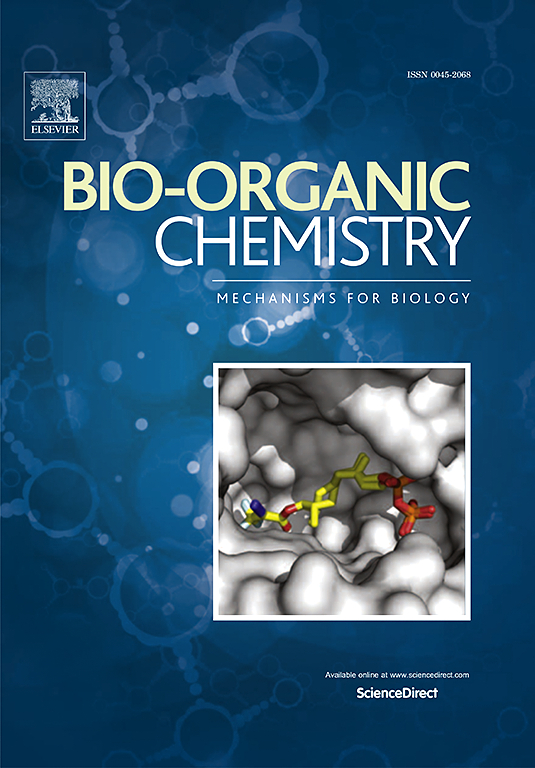Unveiling the potential of xanthines, discovery of potential 7-benzyl-1,3-dimethyl-3,7-dihydro-1H-purine-2,6-dione derivatives with antifibrotic activity for liver injury
IF 4.5
2区 医学
Q1 BIOCHEMISTRY & MOLECULAR BIOLOGY
引用次数: 0
Abstract
A new series of xanthine-based derivatives were designed, synthesized, and investigated to achieve promising antifibrotic and antioxidant agents for management of liver injury. Structure-based optimizations of the methylxanthine-based KMUP-1 (IX) were performed for inhibiting NF-κB activation pathway. All the newly designed xanthine derivatives 3, 4, 5, 6a-d, 7a-d, and 9a-d were in vitro screened for the antioxidant activity using the DPPH method. Compounds 4 and 5 showed the highest antioxidant activity with an IC50 of 28.02 and 36.02 μM, respectively. Compounds 9c and 9d retained a promising interception of the NF-κB activation pathway in molecular docking simulations within I-κB kinase α (IKKα) crystal structure (PDB ID: 5EBZ). Subsequently, compounds 9c and 9d were evaluated for their in vivo antifibrotic and chemoprotective activity using CCl4-induced hepatic fibrosis rat model. Compounds 9c and 9d successfully ameliorated liver fibrosis, as evidenced by the improved liver histopathological examination and liver enzyme activity levels. Compounds 9c and 9d were evaluated for their effects on mRNA expression levels of key genes involved in liver fibrosis via real-time PCR assays. Compound 9c exhibited a greater inhibitory effect on the expression levels of NF-κB and HIF-1α and a more pronounced stimulation of Nrf2 than compound 9d. Moreover, all the new xanthine derivatives were screened for the cytotoxic activity against the NCI tumor cell lines. Compounds 9c and 9d revealed a non-significant cytotoxic activity against all the assayed tumor cell lines, which indicate their selectivity for the antifibrotic activity. While compounds 6a and 6c displayed promising selective activity against melanoma SK-MEL-5 cell line (GI = 125.6, 90.3 %, respectively), and breast T-47D cell line (GI =87.8, 80.6 %, respectively). The utilized design approach unveiled the versatility of xanthine scaffold to deliver potential antioxidant, liver antifibrotic and chemoprotective agents, along with anticancer candidates via structure modification and optimization.

揭示黄嘌呤的潜力,发现具有抗肝损伤纤维化活性的潜在7-苄基-1,3-二甲基-3,7-二氢- 1h -嘌呤-2,6-二酮衍生物
设计、合成和研究了一系列新的基于黄嘌呤的衍生物,以获得有前途的抗纤维化和抗氧化剂,用于肝损伤的治疗。对甲基黄嘌呤基KMUP-1 (IX)进行了结构优化,以抑制NF-κB激活途径。采用DPPH法对新设计的黄嘌呤衍生物3、4、5、6a-d、7a-d和9a-d进行体外抗氧化活性筛选。化合物4和5的抗氧化活性最高,IC50分别为28.02和36.02 μM。在I-κB激酶α (IKKα)晶体结构(PDB ID: 5EBZ)的分子对接模拟中,化合物9c和9d保留了对NF-κB激活途径的有希望的拦截。随后,利用ccl4诱导的肝纤维化大鼠模型,对化合物9c和9d的体内抗纤维化和化学保护活性进行了评价。化合物9c和9d通过改善肝脏组织病理学检查和肝酶活性水平,成功地改善了肝纤维化。通过实时PCR检测化合物9c和9d对肝纤维化关键基因mRNA表达水平的影响。与化合物9d相比,化合物9c对NF-κB和HIF-1α表达水平的抑制作用更大,对Nrf2的刺激作用更明显。此外,对所有新的黄嘌呤衍生物进行了对NCI肿瘤细胞株的细胞毒活性筛选。化合物9c和9d对所有肿瘤细胞系的细胞毒活性均不显著,表明其抗纤维化活性具有选择性。而化合物6a和6c对黑色素瘤SK-MEL-5细胞系(GI分别为125.6和90.3%)和乳腺T-47D细胞系(GI分别为87.8和80.6%)具有良好的选择性活性。该设计方法揭示了黄嘌呤支架的多功能性,通过结构修饰和优化,可以提供潜在的抗氧化剂、肝脏抗纤维化剂和化学保护剂,以及抗癌候选药物。
本文章由计算机程序翻译,如有差异,请以英文原文为准。
求助全文
约1分钟内获得全文
求助全文
来源期刊

Bioorganic Chemistry
生物-生化与分子生物学
CiteScore
9.70
自引率
3.90%
发文量
679
审稿时长
31 days
期刊介绍:
Bioorganic Chemistry publishes research that addresses biological questions at the molecular level, using organic chemistry and principles of physical organic chemistry. The scope of the journal covers a range of topics at the organic chemistry-biology interface, including: enzyme catalysis, biotransformation and enzyme inhibition; nucleic acids chemistry; medicinal chemistry; natural product chemistry, natural product synthesis and natural product biosynthesis; antimicrobial agents; lipid and peptide chemistry; biophysical chemistry; biological probes; bio-orthogonal chemistry and biomimetic chemistry.
For manuscripts dealing with synthetic bioactive compounds, the Journal requires that the molecular target of the compounds described must be known, and must be demonstrated experimentally in the manuscript. For studies involving natural products, if the molecular target is unknown, some data beyond simple cell-based toxicity studies to provide insight into the mechanism of action is required. Studies supported by molecular docking are welcome, but must be supported by experimental data. The Journal does not consider manuscripts that are purely theoretical or computational in nature.
The Journal publishes regular articles, short communications and reviews. Reviews are normally invited by Editors or Editorial Board members. Authors of unsolicited reviews should first contact an Editor or Editorial Board member to determine whether the proposed article is within the scope of the Journal.
 求助内容:
求助内容: 应助结果提醒方式:
应助结果提醒方式:


